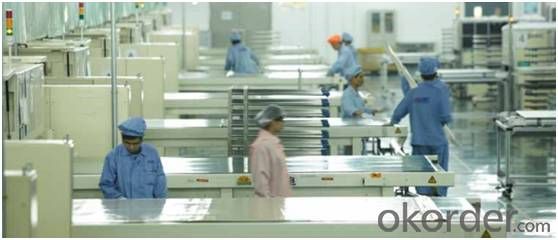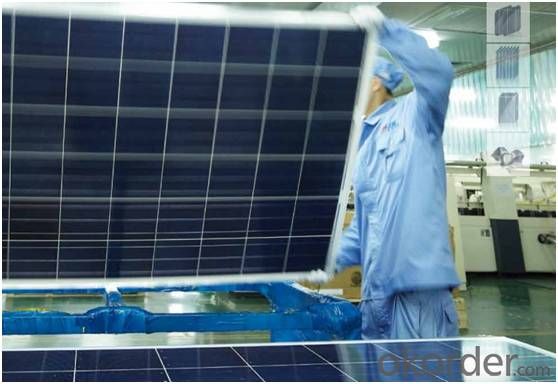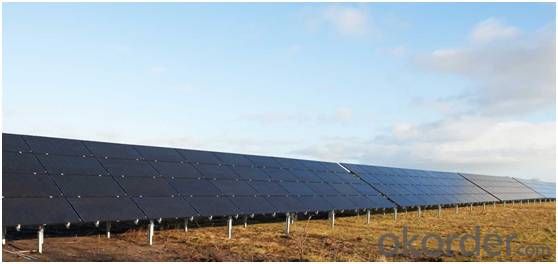Solar Modules (Poly-Crystatline solar Panel)TPB156×156-36-P
- Loading Port:
- Ningbo
- Payment Terms:
- TT OR LC
- Min Order Qty:
- 100 carton
- Supply Capability:
- 10000 carton/month
OKorder Service Pledge
OKorder Financial Service
You Might Also Like

Specification:
· Highest performance enabled by higher efficiency monocrystal line cells and the latest Solar Wafer Technology for multicrystal line cells
· Lower weight design which reduces the total system load on a roof, making it ideal for residential customers. Its shape allows for better roof utilization
· Its low weight means easier handling for installers
· Modules are designed to withstand PID (Potential Induced Degradation)*
· High light transmission Anti-Reflective Glass with improved self-cleaning capability
· 0/+5 W Positive power tolerance for reliable power output
Warranty
CNBM Solar provides one of the most comprehensive module warranties in the industry:
· 10 years for product defects in materials and workmanship
· First 12 years for 90% of warranted minimum power
· Remaining 25 years for 80% of warranted minimum power
Certification
CNBM Solar strictly carries out the ISO 9001 quality control methodology and has implemented check points at every step of the production process to ensure our product performance durability and safety. The stringent quality control process has been confirmed by numerous independent agencies and LDK Solar modules earned IEC, TUV and UL certifications.
· IEC:IEC 61215, IEC 61730 (1&2), conformity to CE
· UL 1703 2002/03/15 Ed:3 Rev:2004/06/30
· ULC/ORD-C1703-01 Second Edition 2001/01/01
· UL and Canadian Standard for Safety Flat-Plate
· ISO 9001: 2008 Quality Management Systems
· CEC Listed: Modules are eligible for California Rebates
· PV Cycle: Voluntary module take back and recycling program
· MCS Certificate



FAQ
Q: How long has Solar PV technology been around?
In 1838 the photoelectric effect was discovered by physicist Edmund Becquerel although it wasn't until the 1950's that the technology was developed enough to produce efficient working cells.
Q: Are Photovoltaic panels expensive?
Over the last 20 years the price of PV modules has fallen dramatically, from around £15 per Wpk in 1980 to current prices of around £3.50 per Wpk.
Q: Will I have to get planning permission?
Not in the vast majority of cases. However if you want your system ground mounted, if your property is part of a world heritage site, or is listed, then planning permission would likely have to be sought in advance.
Q: How long will a Solar PV system last?
The MCS accreditation scheme means that all panels installed under the scheme by approved agents will continue to generate for at least 25 years. Over this time their output will diminish slightly but they should still perform at 85% at the 25 year mark according to the scheme rules.
Q: How much Power can I expect to get from my Solar PV’s?
Typically an installed 1kWpk array will produce 800kWh/year. 2kWpk will produce 1600kWh/year and so on.
- Q:Do solar panels require a battery for energy storage?
- No, solar panels do not require a battery for energy storage. They can be directly connected to the electrical grid and the excess energy generated during the day can be fed back into the grid and used at night or during cloudy periods. However, batteries can be used to store the excess energy for later use, especially in off-grid systems or areas with unreliable grid access.
- Q:Can solar panels be used in space?
- Yes, solar panels can be used in space. In fact, they are extensively used in space missions to generate electricity from sunlight, as there is no atmosphere to block or scatter the sunlight in space. The International Space Station and various satellites rely on solar panels to power their systems and equipment.
- Q:They absorb solar heat and transform it into electricity, so there should be less heat left to warm the planet. Shouldn't we at least plaster all the world's deserts with them?
- No, the top argument is that extra CO2 is inflicting the ambience to keep greater warmth from the sunlight. Having image voltaic panels might scale returned the quantity of CO2 interior the ambience we are putting in it real now via giving us an means source that doesn't emit CO2, and that's approximately it.
- Q:Do solar panels require a battery for storage?
- No, solar panels do not require a battery for storage.
- Q:I have a 2V .5W solar panel and I want to get a battery that can be charged by the solar panel that can then be used to power a 2V .5W fan. Ideally I want all the components to be connected and able to run without interaction. I have very little knowledge in regards to this field which is why I have come to yahoo answers. Any help would be greatly appreciated.
- batteries are rated via the CCA, chilly cranking Amps the better the CCa the longer it is going to very last, don,t imagine you want a cost Controller as your continuously drawing juice from it, the picture voltaic panel will keep the bat at its top , then even as the daylight is down , the pump will draw off the bat,
- Q:What is the impact of roof age on solar panels' efficiency?
- The impact of roof age on solar panels' efficiency can vary depending on the specific condition of the roof. In general, an older roof may need repairs or replacement before installing solar panels to ensure proper installation and optimal performance. Additionally, an aged roof may have structural issues or shading problems that can affect the efficiency of solar panels. Therefore, it is important to assess and address any roof concerns before installing solar panels to maximize their efficiency and longevity.
- Q:Can solar panels be used to power a cruise ship?
- Yes, solar panels can be used to power a cruise ship, but it may not be the sole source of power due to the large energy demands of a cruise ship. However, solar panels can contribute to the overall energy supply of a cruise ship, reducing its reliance on fossil fuels and decreasing its environmental impact.
- Q:i attached a usb charger to my solar panel(it has an output of about .2 volts) but i read on my multimeter its only using about 8 volts however on the conventional wall charger that i use to charge it has an output of about 5. volts.... i believe that my mp3 player is not charging it does not display the charging icon when it is on or off ....is this becuase the output is higher ? do i need to install a volt dropping diode to prevent it from putting to much energy at once? (my mp3 charges fine on the wall charger but does not seem to respond to the solar panel so it the circuits are fine....)
- You description is not clear as to what is supplying and what is consuming the .2, 8, and 5. volts you mention. I get that your solar panel output is .2 VDC (volts DC), but is that open circuit or under load? Also, is the charger output AC or DC? What's using 8 volts? Circuits don't selectively use a portion of the voltage supplied. They use all or nothing. Is the polarity correct from your solar panel to your MP3 player? If your MP3 player requires DC for charging and you're feeding it the correct polarity, but too high a voltage, an overvoltage protection circuit in your MP3 charging circuit might be blocking the charging current from your solar panel. Go through everything again and if you need to post another question on YA, be specific as to what you're measuring, where, and whether it's the source or load you're measuring.
- Q:Can solar panels be installed on a carport or parking lot?
- Yes, solar panels can be installed on a carport or parking lot. This is a popular option to utilize unused space and generate clean energy. It not only provides shade and protection to vehicles but also helps offset electricity costs and reduce carbon emissions.
- Q:when solar panels have served their purpose, what is done with them?
- Solar water heating panels can be salvaged for the copper and aluminum in them. Unless there's catastrophic damage, solar electric panels only weaken with time. Given that serious panels have a life of over 25 years, it's debatable whether anyone would want them after they've served their useful life, any more than someone would want a 386 computer from 985 running at 6 MHz. The glass and metal could be recycled, but the acutal solar cells I think would be thrown away. Contemporary panels are made ROHS compliant with zero lead, so are not especially toxic.
1. Manufacturer Overview |
|
|---|---|
| Location | |
| Year Established | |
| Annual Output Value | |
| Main Markets | |
| Company Certifications | |
2. Manufacturer Certificates |
|
|---|---|
| a) Certification Name | |
| Range | |
| Reference | |
| Validity Period | |
3. Manufacturer Capability |
|
|---|---|
| a)Trade Capacity | |
| Nearest Port | |
| Export Percentage | |
| No.of Employees in Trade Department | |
| Language Spoken: | |
| b)Factory Information | |
| Factory Size: | |
| No. of Production Lines | |
| Contract Manufacturing | |
| Product Price Range | |
Send your message to us
Solar Modules (Poly-Crystatline solar Panel)TPB156×156-36-P
- Loading Port:
- Ningbo
- Payment Terms:
- TT OR LC
- Min Order Qty:
- 100 carton
- Supply Capability:
- 10000 carton/month
OKorder Service Pledge
OKorder Financial Service
Similar products
New products
Hot products
Hot Searches
Related keywords































